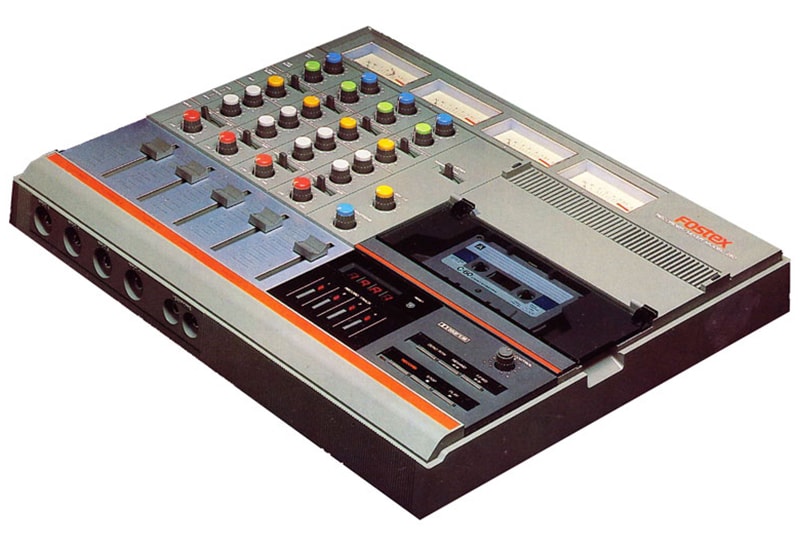During the 1960s and 1970s the notion of a personal studio for an artist to record demos or possibly masters of their songs was still an expensive prospect, involving reel-to-reel multitrack recorders, mixing consoles, and other equipment. Artists who recorded at home to fine-tune their material were all famous musicians. Les Paul, Pete Townshend, Paul McCartney, Stevie Wonder, and Todd Rundgren are among the few who decided to play all of the instruments, and engineer and produce records from those home studio efforts during that era.
However, when Bruce Springsteen released his highly acclaimed 1982 solo acoustic record, Nebraska, much publicity was made over the fact that Springsteen had recorded it at home on a TASCAM 144 Portastudio cassette 4-track unit with a couple of Shure SM57 microphones. Thus, instant credibility was achieved for a novel invention by TEAC’s TASCAM division and an entirely new DIY market was born.
Essentially, the Portastudio used the two left and right channels on each side of a standard audio cassette tape, with its recording head configured to allow for all four tracks to be recorded upon in the same direction (as opposed to flipping over the tape to play both “sides” of cassette on a standard stereo playback machine). With its four VU meters and basic two-band equalization, panning, gain and volume controls all built into a single small desktop unit, the Portastudio 144 made DIY bedroom recording finally available to thousands of musicians, songwriters and producers. (Although home-use four-track reel to reel tape machines like the classic TEAC 2340, A-3340 and A-3340S had been available since the 1970s, their cost put them out of reach for most musicians.)
Three years after the unit’s 1979 debut at AES, TASCAM released the Portastudio 244, which had parametric EQ, DBX noise reduction, varispeed, and simultaneous recording capability on all four tracks.
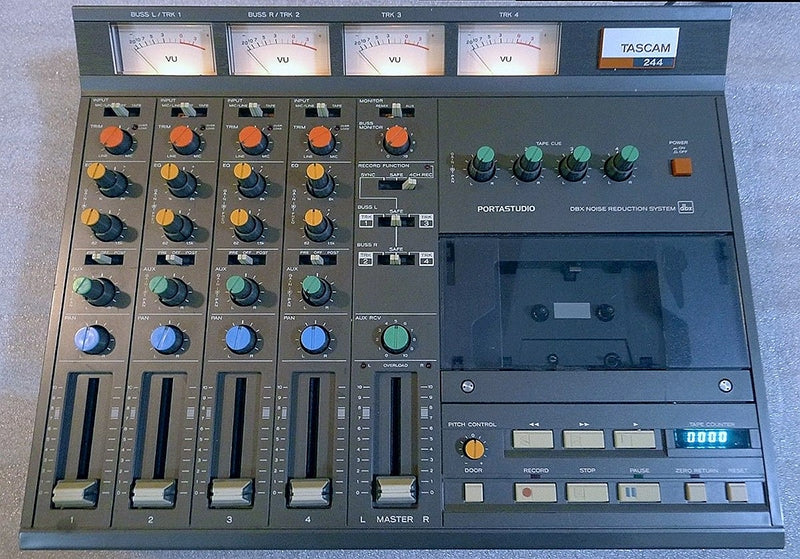
Portastudios were the ideal songwriting tool for home experimentation or for bands on the road. Cassettes were relatively cheap, easy to store, and delivered good-enough sound to be used for commercial music releases, and to be used in conjunction with more professional recording formats. Rival manufacturers including Fostex, Yamaha, Marantz, Akai and Vesta would soon follow, hot on TASCAM’s heels with their own portable multitrack studio-in-a-box offerings.
In 1986, TASCAM released the Portastudio 246, featuring six channels and a higher 3.75 ips (inches per second) tape speed for better sound quality.
TASCAM Portastudio-recorded tracks would subsequently pop up on many singles and albums from artists throughout the 1980s and 1990s. Some of the better-known ones include:
“Kiss From A Rose” – Seal
New York (various tracks and original demos) – Lou Reed
Smile From The Streets You Hold – John Frusciante
Enter the Wu-Tang (36 Chambers) – Wu-Tang Clan
Fostex had its own line of compact 4-track cassette recording units that competed with TASCAM. In 1983 Fostex launched the X-15, which was about the size of a hardcover book and pared down the controls to a bare minimum, while still maintaining the primary recording and playback functions required by most users. Its main advantage over the Portastudio was its genuine portability – it also worked on batteries, thus making it an excellent multitrack field recording unit. TASCAM’s Porta One, a competing battery-powered unit, would not reach the market until the 1990s.
Apart from their cassette multitrack units, Fostex also created the first 16-track half-inch reel-to-reel deck designed for home studio recording: the B-16. Its popularity was so great that at one point, Ampex had a problem meeting demand for the half-inch-format 456 recording tape that the B-16 used. The B-16 became the cornerstone of Be-Bop Deluxe founder Bill Nelson’s home studio in the UK. He used it to record and release some two dozen or more albums.
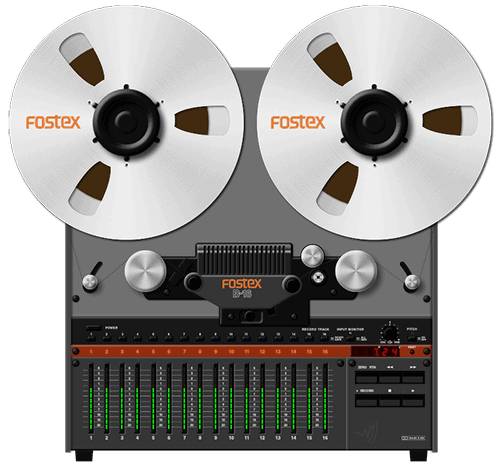 Fostex B-16 multitrack recorder.
Fostex B-16 multitrack recorder.Yamaha’s MT2X, MT50 and other MT Series multitrack cassette recorders competed head-to-head with the Fostex X-15 as battery-powered studio-in-a-box field recorders. However, Yamaha also decided to compete with the desktop form factor Portastudios by offering a mixer designed to work with Yamaha’s MT multitrack units: the MG10/2 Series. Sporting RCA jacks for easy connections, individual effects sends on each channel, and several extra inputs for adding additional sounds on the fly in a mix, the Yamaha MG 10/2 instilled a degree of mixing flexibility that superseded both TASCAM’s and Fostex’s products at the time.
At the height of the 4-track cassette recording boom, one of the more popular ads at the time for these machines featured the cover of the Beatles’ Sgt. Pepper album with the caption, “it was recorded on a 4-track machine…and now you can have one too!”
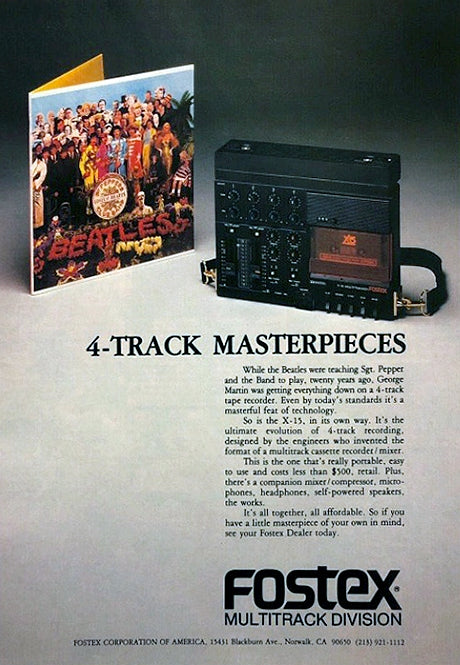
Technology continued to push the envelope in the 1990s, and features like balanced XLR input jacks with phantom power, LED and LCD meters, and higher input channel counts on more expensive models became more prevalent. Also, cheaper models with fewer features, like shelving instead of parametric EQ, and the reduction of four separate input busses to two L/R busses, lowered the entry point for buying a multitrack recorder. With the awareness that MIDI (Musical Instrument Digital Interface) had become the key factor in syncing drum machines and keyboards with digital sequencers, TASCAM released its 644 (4-track) and 688 (8-track) MIDIstudio recorders, which were essentially Portastudios with MIDI routing capability.
TASCAM unveiled its 488, the first 8-track Portastudio, at a time when DAT (Digital Audio Tape) had already hit the market, and digital sampling was becoming popular. Despite squeezing eight tracks onto a cassette at roughly 0.25mm track width per track, the 488 Portastudio specs touted a 40Hz-14 kHz bandwidth and a 90dB S/N ratio with less than 70dB crosstalk. One drawback was that the parametric EQ of the 244 had been replaced by a simpler low- (100 Hz) and high- (10 kHz) 12dB cut/boost configuration. Although there were two effects sends, only one or the other could be engaged in a channel strip, not both.
Acknowledging the need for syncing to MIDI, the 488 had automatic bypass routing to track 8 in order to record a MIDI sync tone.
The biggest drawback of the 488 was its lack of outputs for use with external amps and speakers. It only had a headphone output, which meant that working with other musicians and any kind of serious mixing would require feeding the headphone output into an amplifier via some kind of adapter or outboard unit.
Inevitably, analog cassette-based multitrack recorders would be superseded by digital technology. In 1992 Alesis introduced the first (relatively) compact multitrack digital recorder, the 8-track ADAT, which used the then-new DAT (Digital Audio Tape). Tascam followed in 1993 with its DA-88, which recorded on 8 mm videotape. Companies like Korg, Zoom, Roland and others followed. Analog cassette tapes as a medium were eclipsed by compact multitrack recorders with internal hard disc drives and the ability to record onto recordable CD burners, and later onto SD Cards and flash drives.
Although so much recording today is done using computers running DAW (Digital Audio Workstation) software, many musicians and producers still want the ease of use and workflow of using actual recording machines. While it’s true that the flexibility and features of a DAW with plug-ins are widening the technology and functionality gap compared to standalone compact recorders, the latter still retain a loyal following and now boast vastly superior sound quality and storage capability, in the same-sized packages as their predecessors from 40 years ago. Units such as the TASCAM Portastudio DP-32SD can also connect to a DAW via USB and can seamlessly merge tracks via direct uploads, or create files that can then be emailed to other musicians for remote collaboration. The compact recorders of today also sport DSP reverb, delay, chorus, compression, distortion, and other effects, that often are quieter than outboard rack-mounted gear.
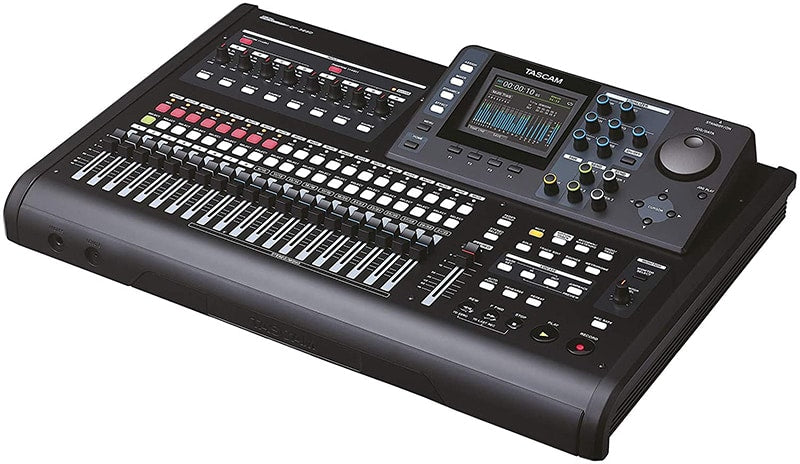 TASCAM DP-32SD digital multitrack recorder.
TASCAM DP-32SD digital multitrack recorder.Perhaps the full-circle irony of the Portastudio saga is that in 2010, TASCAM released an iPad app of the Portastudio 144.
The book isn’t closed on those old analog machines. With over one million units sold since 1979, multitrack cassette recorders will likely be around for a long time. Dozens are advertised on eBay and other outlets every day. Artists from Springsteen to Lady Gaga, who received a Portastudio as a gift from her father while in her teens, are fans, and still use them for the creative mojo and inspiration they deliver.
Header image: Fostex 250 cassette multitrack recorder.

